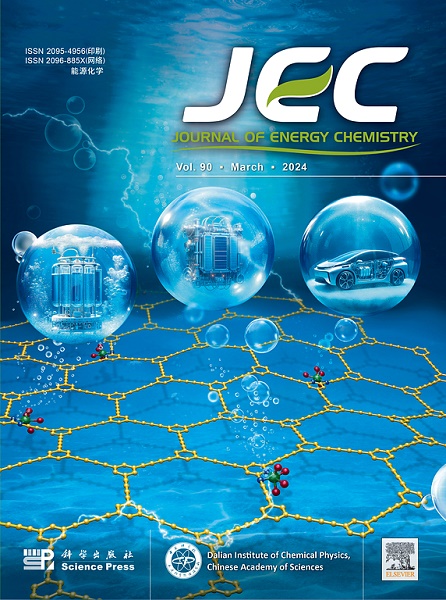Re-adsorption of leached Cr species during the surface reconstruction of NiFeCr layered double hydroxides enhances the oxygen evolution reaction
IF 13.1
1区 化学
Q1 Energy
引用次数: 0
Abstract
Cr leaching is anticipated to extensively advance the activity of Cr-containing catalysts towards the oxygen evolution reaction (OER), but the underlying catalytic enhancement mechanism requires further investigation. Herein, NiFeCr layered double hydroxide (NiFeCr-LDH) is proposed as a proof-of-concept catalyst to elucidate the evolution of Cr species and its enhancement mechanism in OER. The incorporation of Cr(Ⅲ) ions into the lattice of NiFe-LDH is achieved through a meticulously controlled electrodeposition process, which not only promotes Cr leaching but also deepens surface reconstruction. More importantly, experimental and theoretical results demonstrate that protogenetic CrO42− anions, derived from the oxidation of leached Cr ions, adsorb onto the surface NiFeCr-LDH under the anodic potential to create a CrO42−-rich electrical double layer (CrO42−-rich EDL) and function as co-catalyst to trigger OER. CrO42−-rich EDL integrated with vacancies balances the Gibbs free energies of the reconstructed NiFeCr-LDH for oxygen-containing intermediates, resulting in an exceptionally low overpotential of 286 mV at 500 mA cm−2, which outperforms most state-of-the-art metallic catalysts. Additionally, the anion exchange membrane water electrolysis system assembled with NiFeCr-LDH and Pt/C demonstrates 1000-h stability at a current density of 1.0 A cm−2 under a voltage of 1.74 V (at 70 °C), highlighting its promising potential for practical, large-scale and sustainable applications.

求助全文
约1分钟内获得全文
求助全文
来源期刊

Journal of Energy Chemistry
CHEMISTRY, APPLIED-CHEMISTRY, PHYSICAL
CiteScore
19.10
自引率
8.40%
发文量
3631
审稿时长
15 days
期刊介绍:
The Journal of Energy Chemistry, the official publication of Science Press and the Dalian Institute of Chemical Physics, Chinese Academy of Sciences, serves as a platform for reporting creative research and innovative applications in energy chemistry. It mainly reports on creative researches and innovative applications of chemical conversions of fossil energy, carbon dioxide, electrochemical energy and hydrogen energy, as well as the conversions of biomass and solar energy related with chemical issues to promote academic exchanges in the field of energy chemistry and to accelerate the exploration, research and development of energy science and technologies.
This journal focuses on original research papers covering various topics within energy chemistry worldwide, including:
Optimized utilization of fossil energy
Hydrogen energy
Conversion and storage of electrochemical energy
Capture, storage, and chemical conversion of carbon dioxide
Materials and nanotechnologies for energy conversion and storage
Chemistry in biomass conversion
Chemistry in the utilization of solar energy
 求助内容:
求助内容: 应助结果提醒方式:
应助结果提醒方式:


